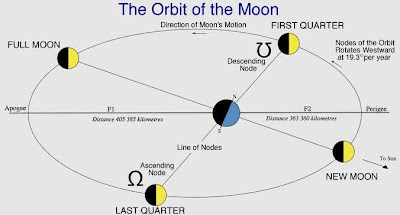On Sunday 7 July, at 0.37 am GMT, the Moon will be at its furthest point from the Earth in 2013, a distance of 406 491 km. The Moon orbits the Earth every 27.5 days, and like most orbiting bodies, its orbit is not completely circular, but slightly elliptical, so that the distance between the two bodies varies by about 3% over the course of a month. This elliptical orbit is also not completely regular, it periodically elongates then returns to normal, making some perigees closer than others. Because this is an elongating and contracting elliptical orbit, rather than a change in the average distance between the Earth and the Moon, the most extreme Lunar Perigee and Apogee of each year typically happen in the same Lunar Month. In this case the nearest approach of the Moon to the Earth came on 23 June (two weeks before the Apogee), and was widely reported in the press as a 'supermoon', since it coincided with the Full Moon. The Apogee, in contrast, will happen 30 hours and 39 minutes before the New Moon, making it rather less notable.
Diagram showing the relationship of the Lunar orbit and Lunar month. Southern Astronomical Delights.
Although this is the furthest point from the Earth that the Moon will reach in 2013, it is not exceptional. The Moon reached 406 655 km from the Earth on 2 April 2011, and will reach 506 536 on 16 January 2014.
See also The Earth's aphelion, The Lunar Perigee, The Northern Solstice, Total eclipse of the Sun visible from Australia, Papua New Guinea and the Solomon Islands, 9 May 2013 and The Earth approaches its perihelion.
Follow Sciency Thoughts on Facebook.

